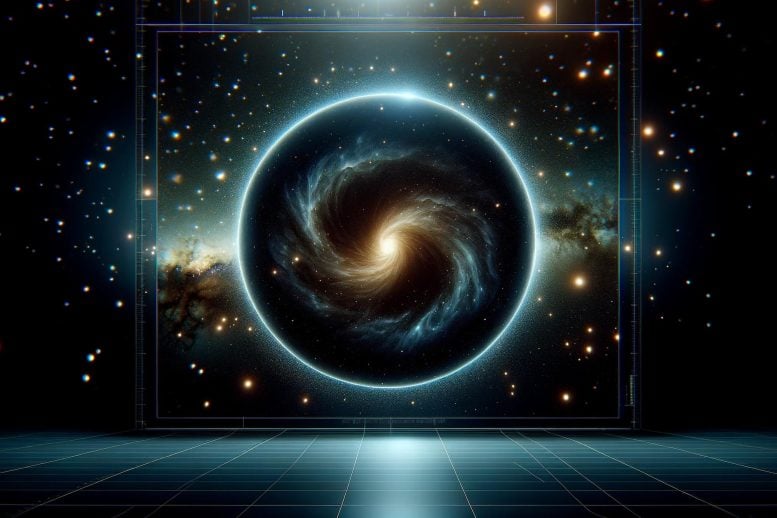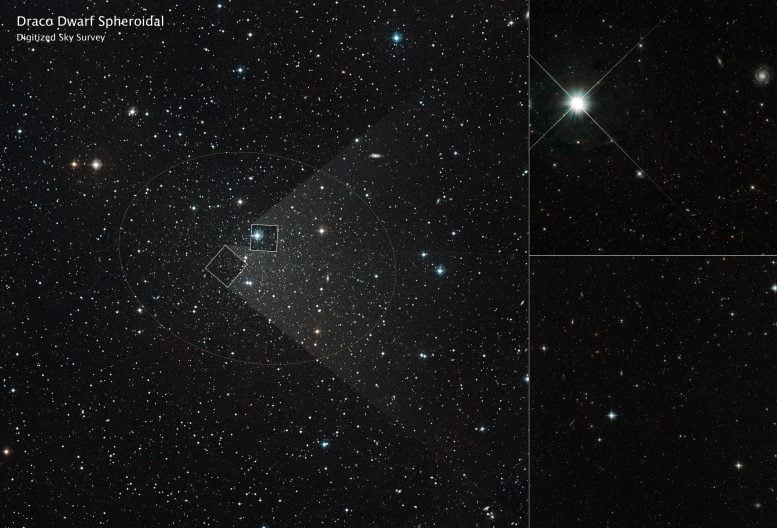
Posted on 07/30/2024 5:56:12 AM PDT by Red Badger

A long-term Hubble Space Telescope study of the Draco dwarf galaxy’s stars suggests dark matter is concentrated at the galaxy’s center, supporting the density cusp theory. This finding challenges earlier observations and improves our understanding of dark matter’s role in galaxy formation. (Artist’s concept.) Credit: SciTechDaily.com
===================================================================================
The Hubble Space Telescope’s longevity is an asset in gaining clarity about the universe’s invisible glue. When theory and observations favor different results, how can astronomers determine which one is more feasible?
Increasing confidence in one theory over another oftentimes requires building a richer dataset to improve current models and lower uncertainties. A team of scientists have done just that to help alleviate the murkiness of a long-standing debate: the cusp-core problem. By analyzing NASA’s Hubble Space Telescope data gathered over an almost two-decade span, astronomers have charted stellar movements within a galaxy and discovered the likely clumping of dark matter in its center.

Draco Dwarf Spheroidal
A team of astronomers analyzed observations by NASA’s Hubble Space Telescope taken over a span of 18 years to measure the dynamic motions of stars within the Draco dwarf galaxy. The telescope’s extensive baseline and data archive enabled the team to build the most accurate three-dimensional map of the stars’ movements within the system. These improved measurements are helping to shed “light” on the mysterious qualities and behavior of dark matter, the universe’s invisible “glue.” Credit: NASA, ESA, Eduardo Vitral (STScI), Roeland van der Marel (STScI), Sangmo Tony Sohn (STScI), DSS, Joseph DePasquale (STScI)
===================================================================================
Hubble Space Telescope Traces Dark Matter in Dwarf Galaxy Using Stellar Motions
The qualities and behavior of dark matter, the invisible “glue” of the universe, continue to be shrouded in mystery. Though galaxies are mostly made of dark matter, understanding how it is distributed within a galaxy offers clues to what this substance is, and how it’s relevant to a galaxy’s evolution.
While computer simulations suggest dark matter should pile up in a galaxy’s center, called a density cusp, many previous telescopic observations have indicated that it is instead more evenly dispersed throughout a galaxy. The reason for this tension between model and observation continues to puzzle astronomers, reinforcing the mystery of dark matter.
Leveraging the Hubble Telescope
A team of astronomers has turned toward NASA’s Hubble Space Telescope to try and clarify this debate by measuring the dynamic motions of stars within the Draco dwarf galaxy, a system located roughly 250,000 light-years from Earth. Using observations that spanned 18 years, they succeeded in building the most accurate three-dimensional understanding of stars’ movements within the diminutive galaxy. This required scouring nearly two decades of Hubble archival observations of the Draco galaxy.
“Our models tend to agree more with a cusp-like structure, which aligns with cosmological models,” said Eduardo Vitral of the Space Telescope Science Institute (STScI) in Baltimore and lead author of the study. “While we cannot definitively say all galaxies contain a cusp-like dark matter distribution, it’s exciting to have such well measured data that surpasses anything we’ve had before.”
Advanced Techniques for Stellar Motion
To learn about dark matter within a galaxy, scientists can look to its stars and their movements that are dominated by the pull of dark matter. A common approach to measure the speed of objects moving in space is by the Doppler Effect – an observed change of the wavelength of light if a star is approaching or receding from Earth. Although this line-of-sight velocity can provide valuable insight, only so much can be gleaned from this one-dimensional source of information.
Besides moving closer or farther away from us, stars also move across the sky, measured as their proper motion. By combining line-of-sight velocity with proper motions, the team created an unprecedented analysis of the stars’ 3D movements.
“Improvements in data and improvements in modeling usually go hand in hand,” explained Roeland van der Marel of STScI, a co-author of the paper who initiated the study more than 10 years ago. “If you don’t have very sophisticated data or only one-dimensional data, then relatively straightforward models can often fit. The more dimensions and complexity of data you gather, the more complex your models need to be to truly capture all the subtleties of the data.”
A Scientific Marathon (Not a Sprint)
Since dwarf galaxies are known to have a higher proportion of dark matter content than other types of galaxies, the team honed in on the Draco dwarf galaxy, which is a relatively small and spheroidal nearby satellite of the Milky Way galaxy.
“When measuring proper motions, you note the position of a star at one epoch and then many years later measure the position of that same star. You measure the displacement to determine how much it moved,” explained Sangmo Tony Sohn of STScI, another co-author of the paper and the principal investigator of the latest observational program. “For this kind of observation, the longer you wait, the better you can measure the stars shifting.”
The team analyzed a series of epochs spanning from 2004 to 2022, an extensive baseline that only Hubble could offer, due to the combination of its sharp stable vision and record time in operation. The telescope’s rich data archive helped decrease the level of uncertainty in the measurement of the stars’ proper motions. The precision is equivalent to measuring an annual shift a little less than the width of a golf ball as seen on the Moon from Earth.
With three dimensions of data, the team reduced the amount of assumptions applied in previous studies and considered characteristics specific to the galaxy – such as its rotation, and distribution of its stars and dark matter – in their own modeling efforts.
Implications and Future Research
The methodologies and models developed for the Draco dwarf galaxy can be applied to other galaxies in the future. The team is already analyzing Hubble observations of the Sculptor dwarf galaxy and the Ursa Minor dwarf galaxy.
Studying dark matter requires observing different galactic environments, and also entails collaboration across different space telescope missions. For example, NASA’s upcoming Nancy Grace Roman Space Telescope will help reveal new details of dark matter’s properties among different galaxies thanks to its ability to survey large swaths of the sky.
“This kind of study is a long-term investment and requires a lot of patience,” reflected Vitral. “We’re able to do this science because of all the planning that was done throughout the years to actually gather these data. The insights we’ve collected are the result of a larger group of researchers that has been working on these things for many years.”
These results were published on July 11 in The Astrophysical Journal.
Reference:
“HSTPROMO Internal Proper-motion Kinematics of Dwarf Spheroidal Galaxies. I. Velocity Anisotropy and Dark Matter Cusp Slope of Draco” by Eduardo Vitral, Roeland P. van der Marel, Sangmo Tony Sohn, Mattia Libralato, Andrés del Pino, Laura L. Watkins, Andrea Bellini, Matthew G. Walker, Gurtina Besla, Marcel S. Pawlowski and Gary A. Mamon, 11 July 2024, The Astrophysical Journal.
DOI: 10.3847/1538-4357/ad571c
The Hubble Space Telescope (HST) is a groundbreaking orbiting observatory launched in 1990 by NASA in partnership with the European Space Agency. Situated outside the distortion of Earth’s atmosphere, Hubble provides exceptionally clear and deep views of the universe, ranging from our solar system to the most distant galaxies and the elusive cosmic phenomena in between. Over the decades, Hubble has played a critical role in many of the most significant discoveries in astronomy, including the expansion rate of the universe, the presence of black holes at the centers of galaxies, and the atmospheric composition of exoplanets. Its suite of advanced instruments and continuous upgrades allow astronomers worldwide to conduct high-resolution observations that ground telescopes could not easily match, making it one of the most valuable tools in the study of the cosmos.
Remember, ‘GRAVITY’ is just a label......................
Cosmic glue was described in Scripture. Colossians 3:17, speaking of Jesus Christ: “He is before all things and in Him, all things hold together.”
I don’t know what version of Colossians that is..........
Colossians 3:17
King James Version
17 And whatsoever ye do in word or deed, do all in the name of the Lord Jesus, giving thanks to God and the Father by him.
It is mind boggling how many suns and planets are in the universe. And how large the universe is. We earthlings are just a grain of sand in the vast Pacific ocean.
More confirmation that something’s being missed.
This is what I have been saying for over thirty years as the balancing anti-matter is perceived as dark matter and the black hole is the window through which it is connected to our visible reality.
Acts 17:26
And hath made of one blood all nations of men for to dwell on all the face of the earth, and hath determined the times before appointed, and the bounds of their habitation;
Dark matter is kinda like God. Nobody sees it, but they see its effect, so they believe in it/Him.
However, of the two religions (science and Christianity) I choose the latter. Though science is fun and productive, all it does is give us a window into how God’s creation exists. It makes for a lousy religion.
If you shine a flashlight into the sky and their is nothing to reflect the light back to you, the light appears to be dark matter. It is merely energy traveling in the opposite direction.
Science is man’s meager attempt to explain God.................
“Are the stars out tonight?
I don’t know if it’s cloudy or bright.
They all disappear from view.
Cause the dark matter gets in the way.”
Nah.
I like the original better.
It’s Colossians 1:17
“Dark matter is kinda like God. Nobody sees it, but they see its effect, so they believe in it/Him.”
“However, of the two religions (science and Christianity) I choose the latter. Though science is fun and productive, all it does is give us a window into how God’s creation exists. It makes for a lousy religion.”
There is a higher level of understanding where science and religion become one body of knowledge. However, it can not be understood without experiencing both. Knowledge alone will not bring the two together.
I’m a Bible believing Christian, but also believe in Science. Science is the process of discovering how God works.

Yes. Science is a lousy religion. But, Science helps us understand creation, and how to dominate the earth.
Absofrickinlutely. It annoys me when people think they can get God out of science, and it annoys me when people think they can get science from the Bible.
Science is about how
Religion is about why.
“Why” is the higher pursuit.
So there is either “Dark Matter” accounting for stellar matter, moving in unexpected ways - something we cannot detect, see, or measure ..
Or, space itself is stretching due to gravitational effects, by unknown masses we can neither see nor detect.
Once we get to Quantum realm, things stop making sense; or when we get to astronomic scales; things stop making sense.
They are two ends of the same ruler........................
Disclaimer: Opinions posted on Free Republic are those of the individual posters and do not necessarily represent the opinion of Free Republic or its management. All materials posted herein are protected by copyright law and the exemption for fair use of copyrighted works.